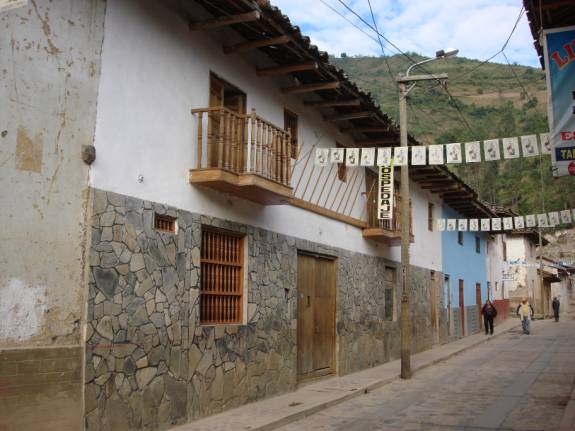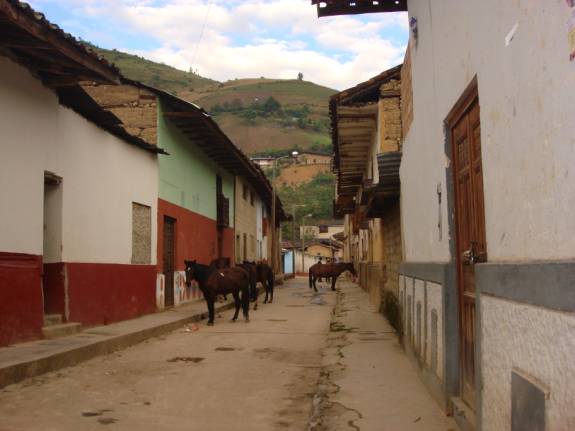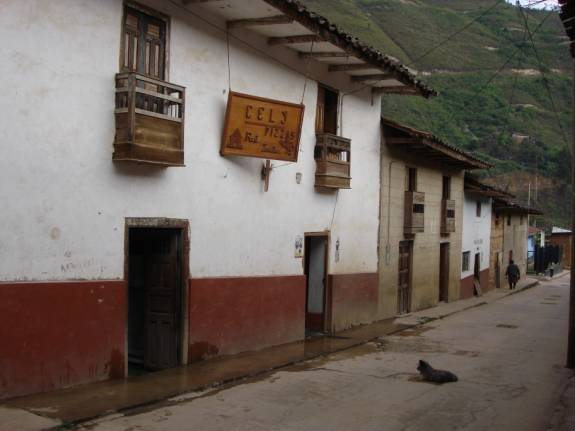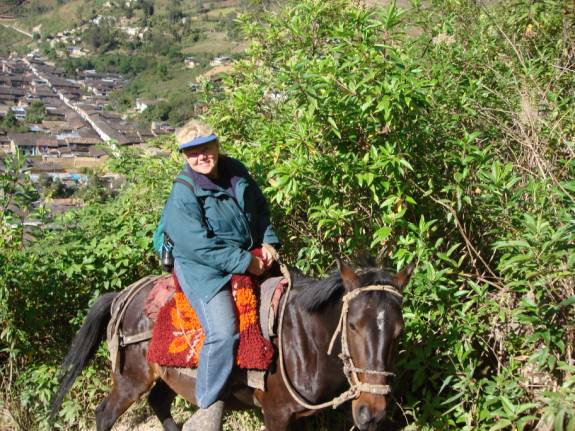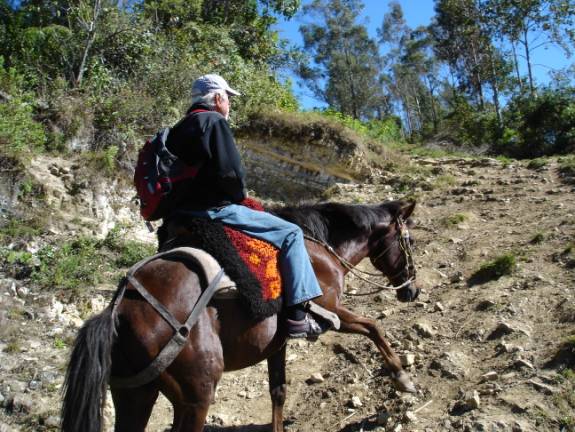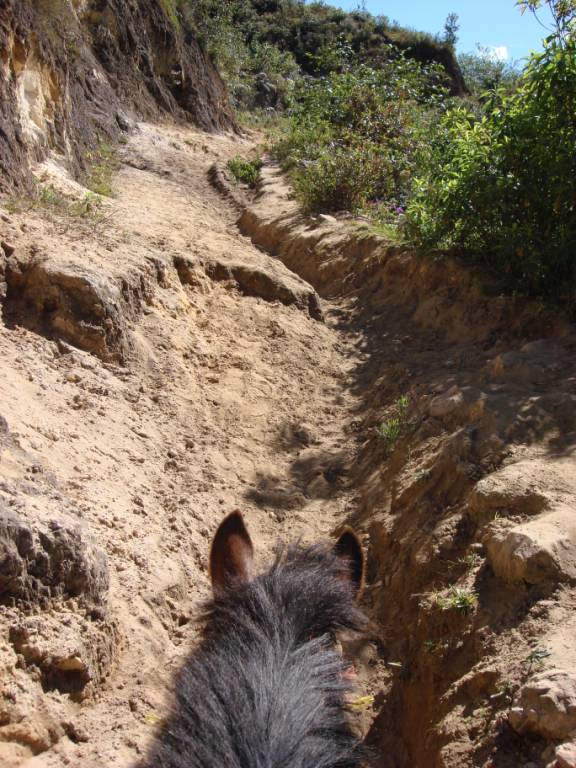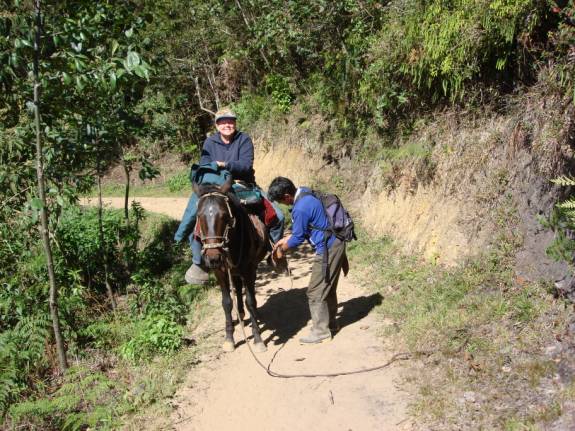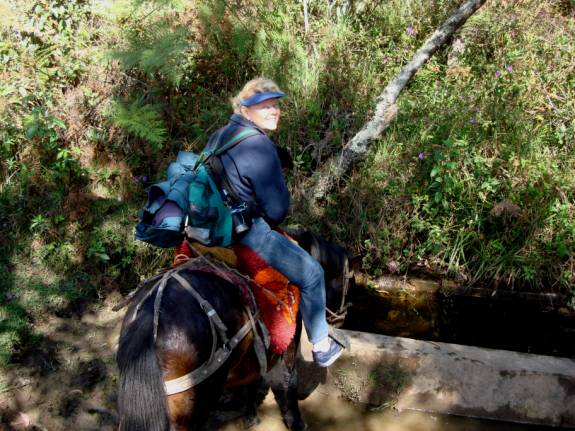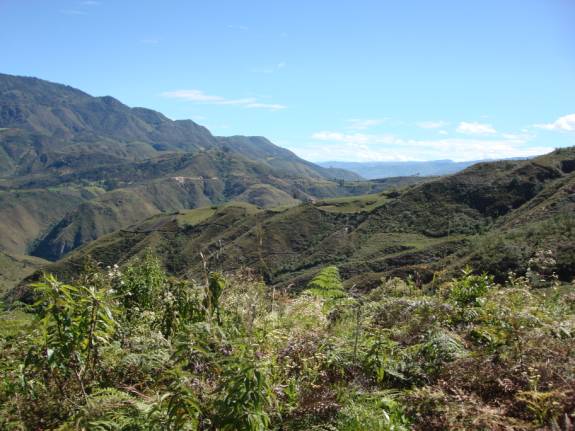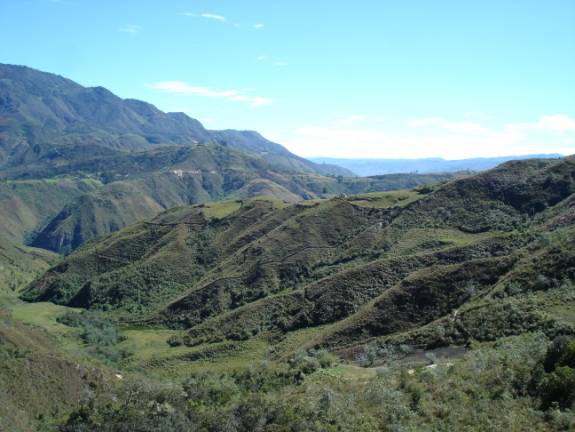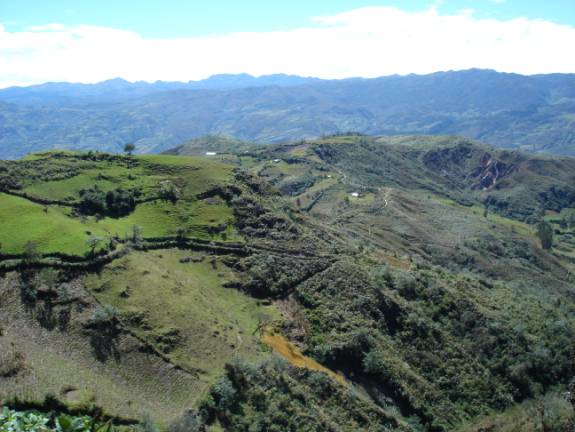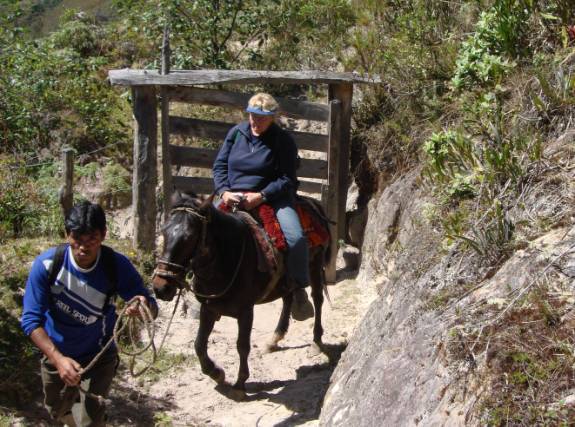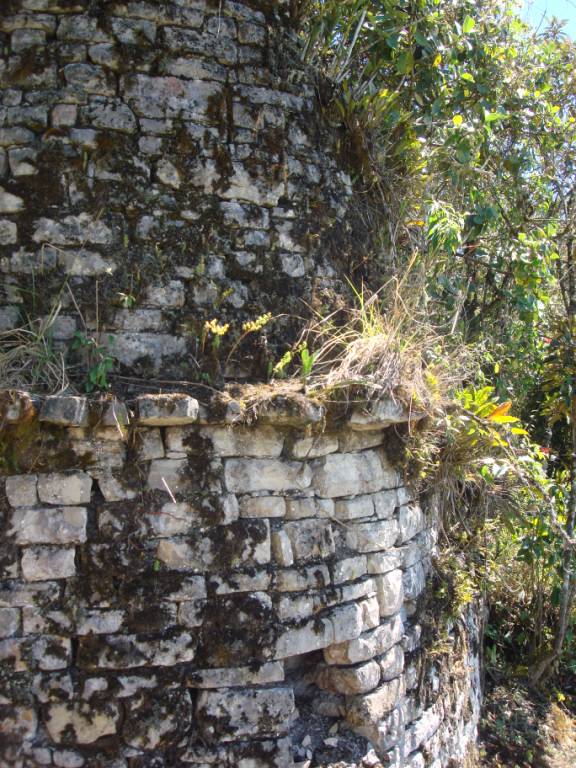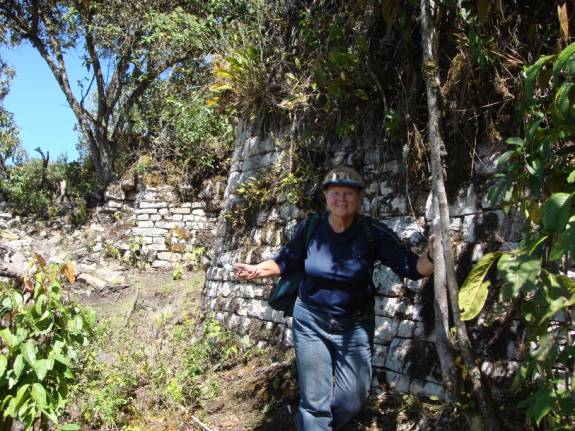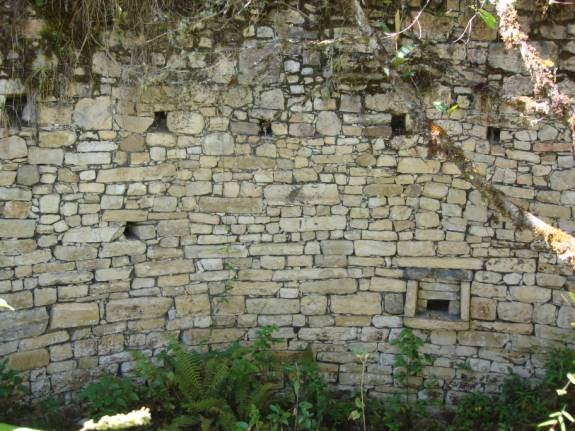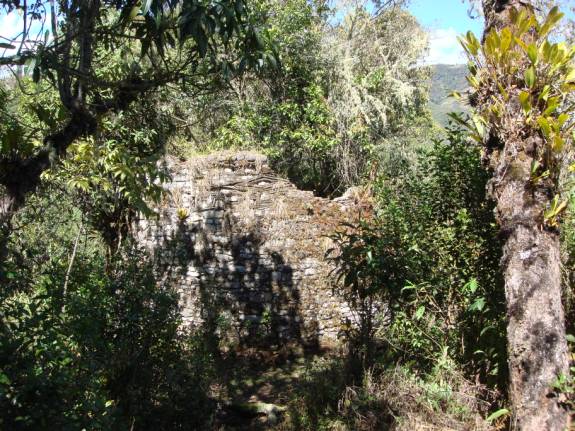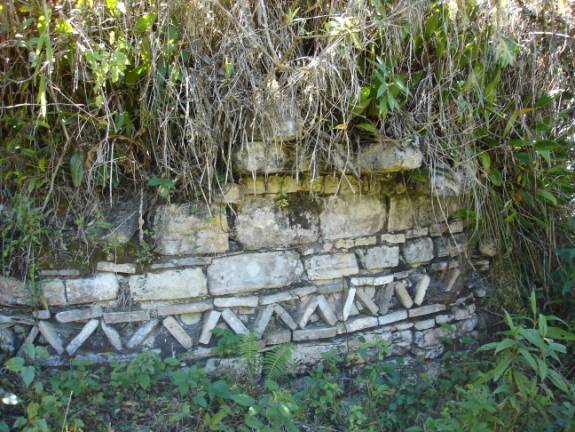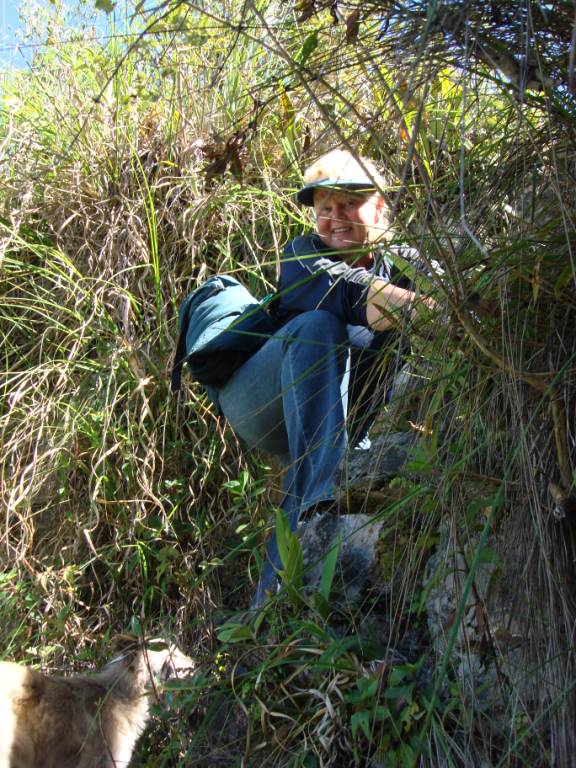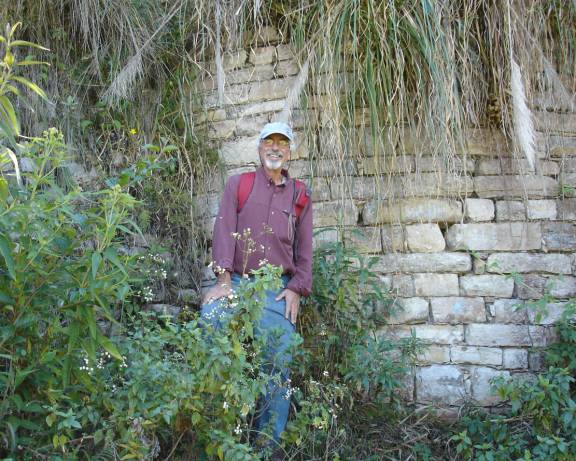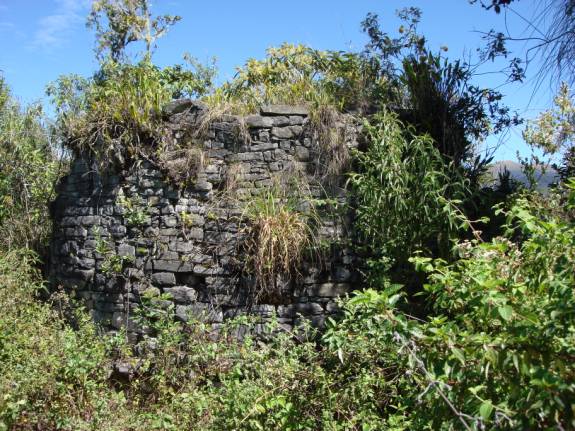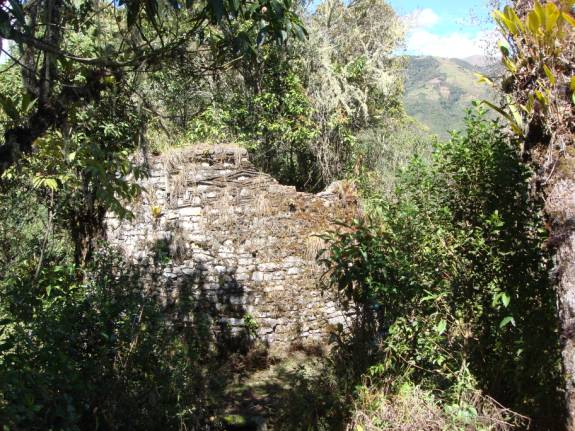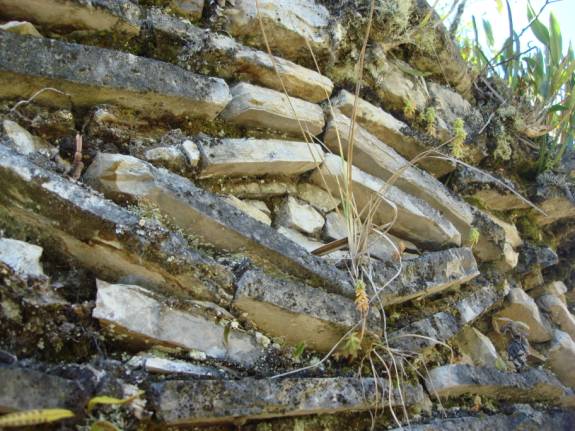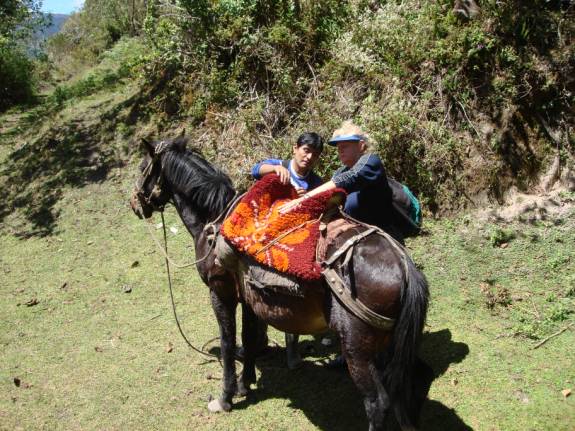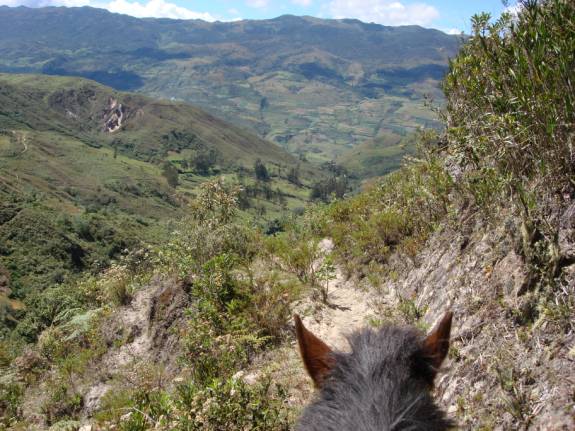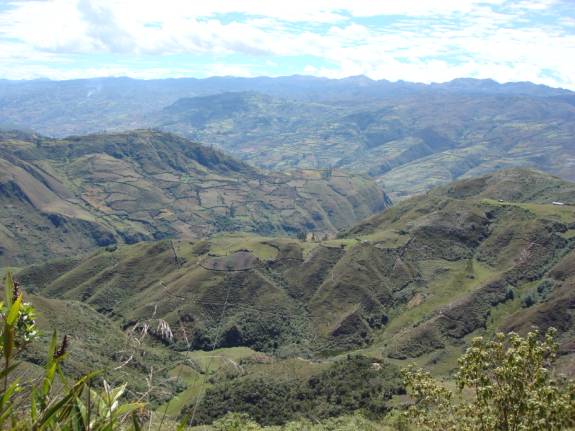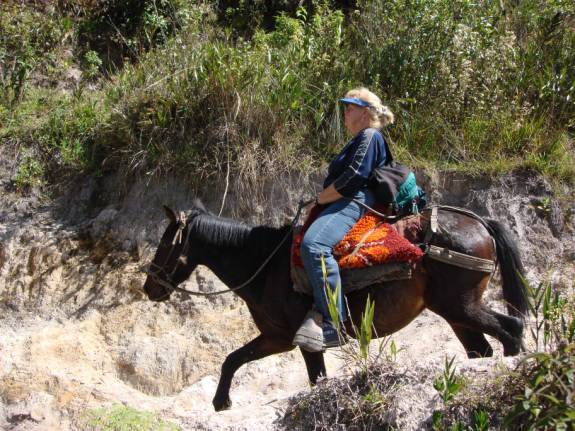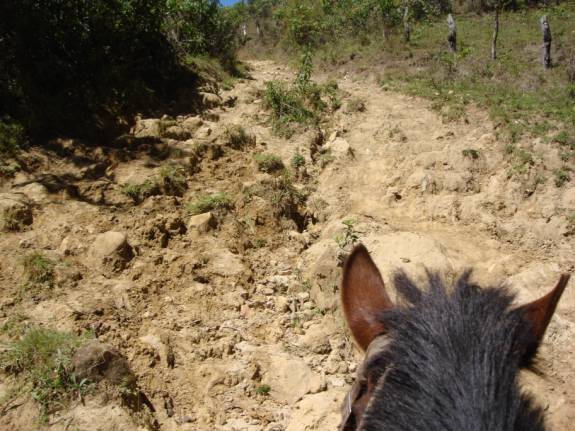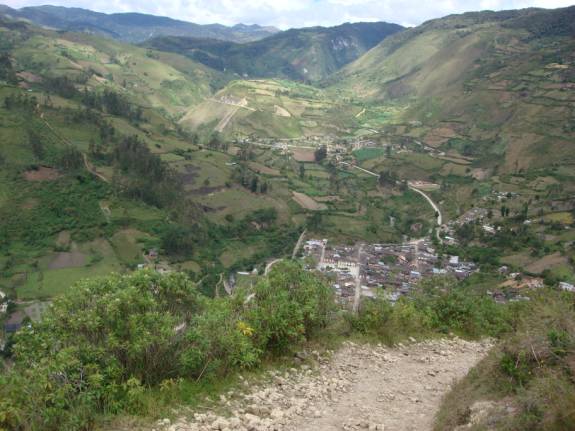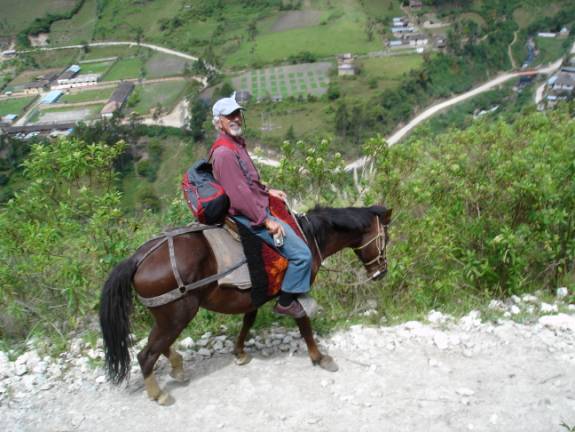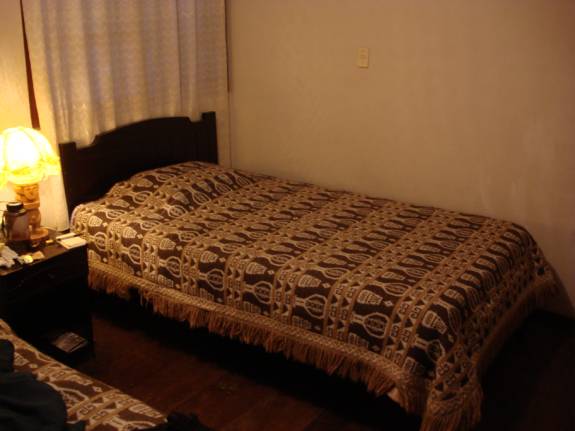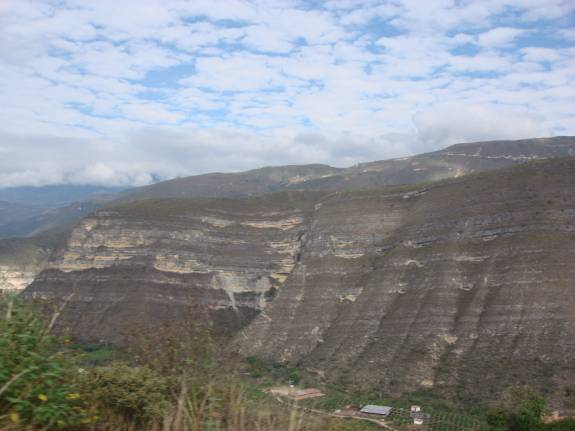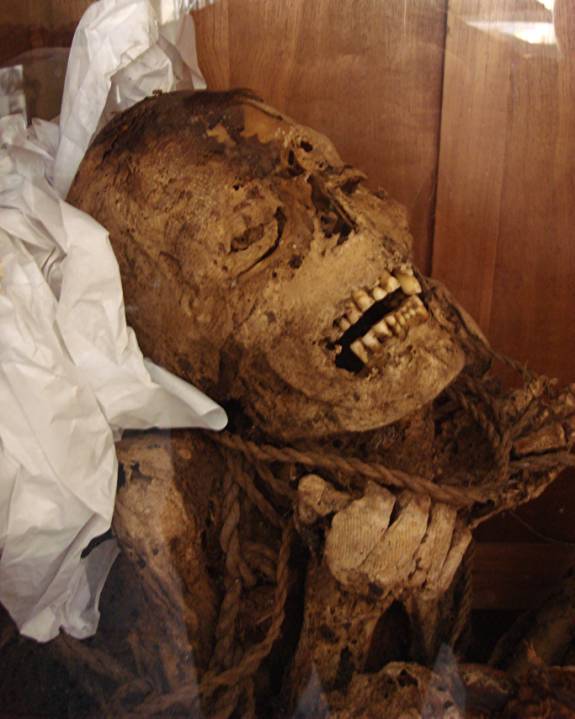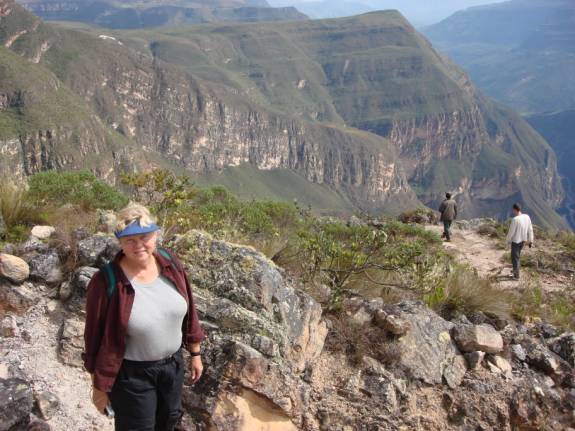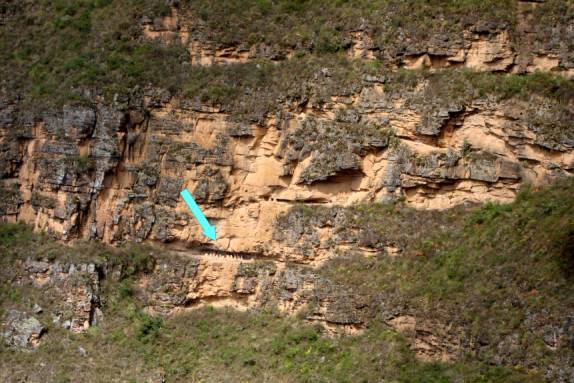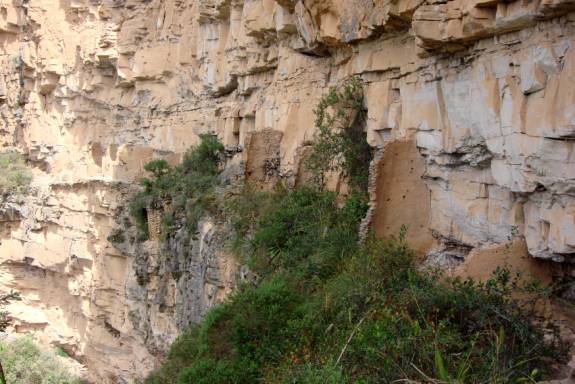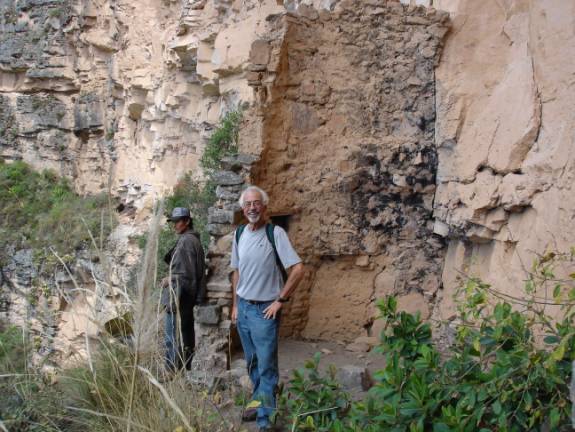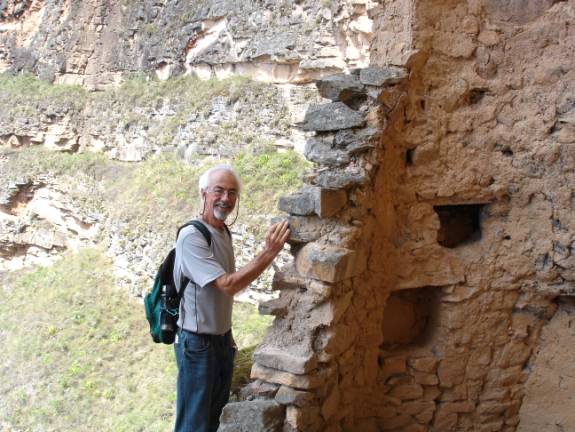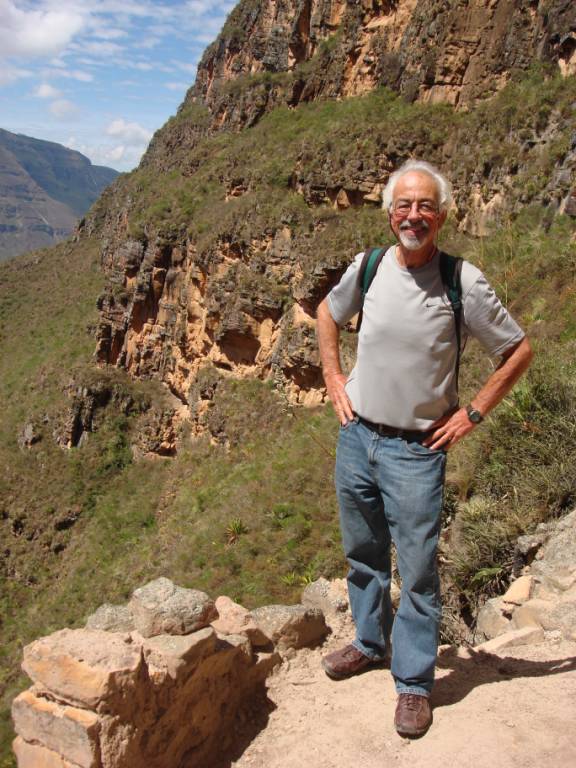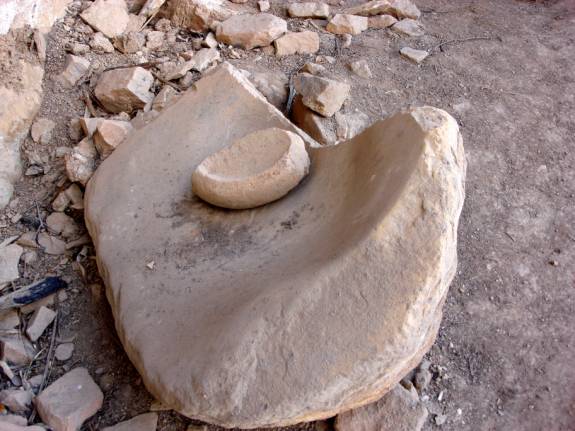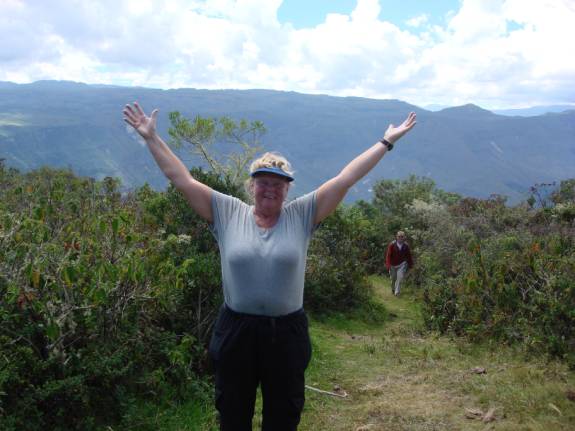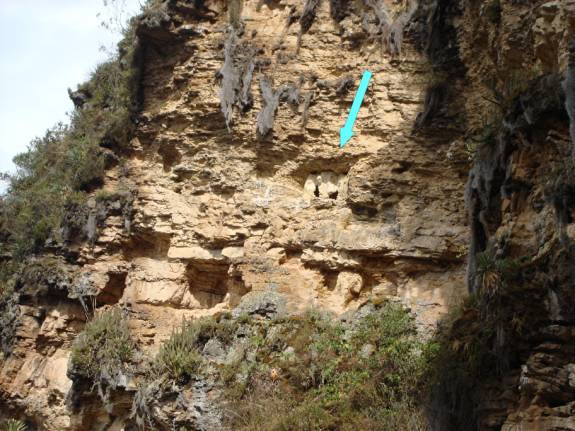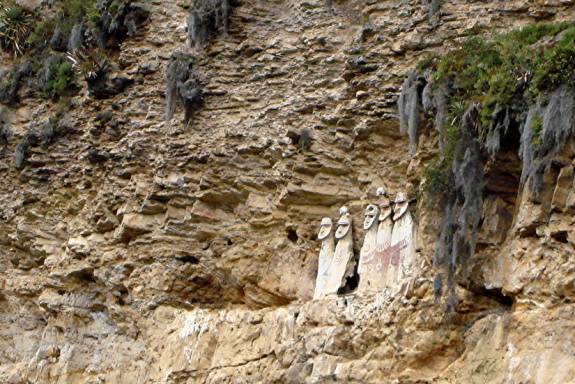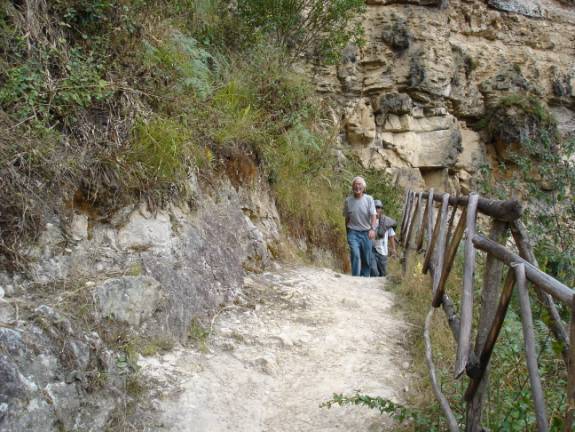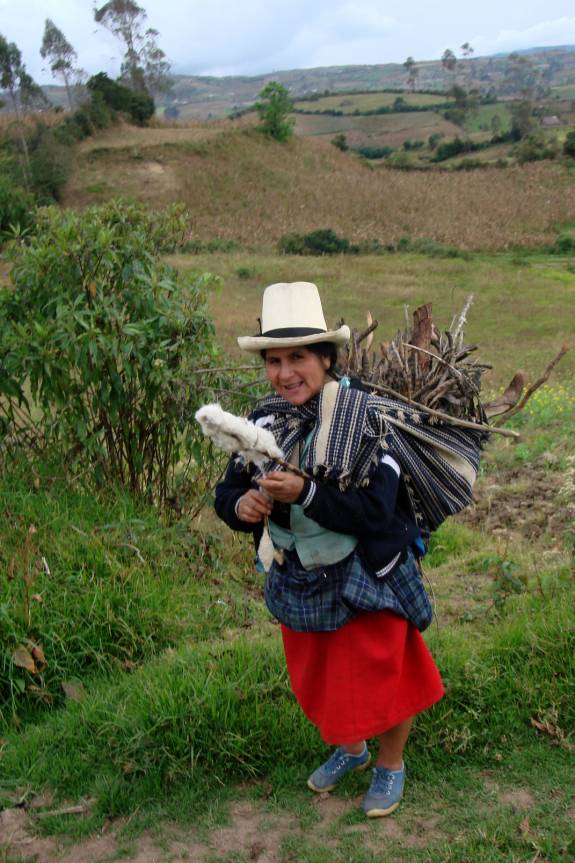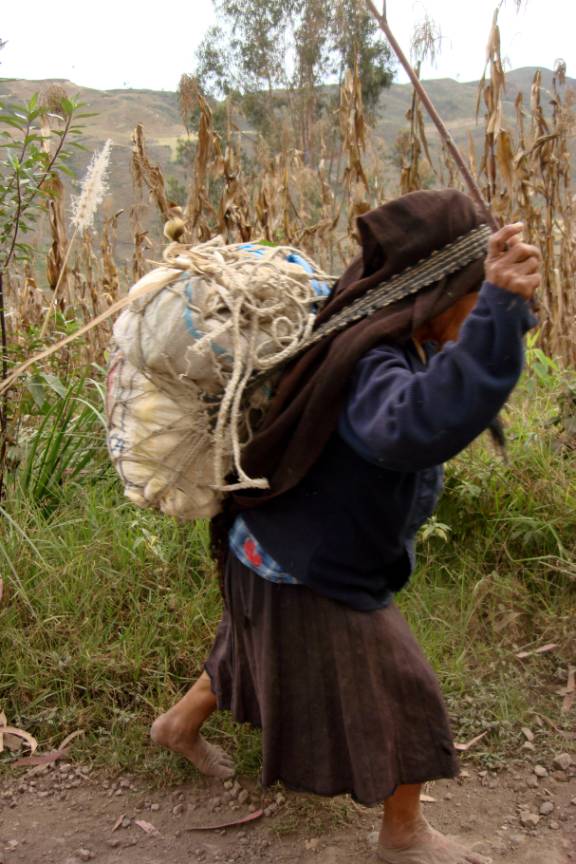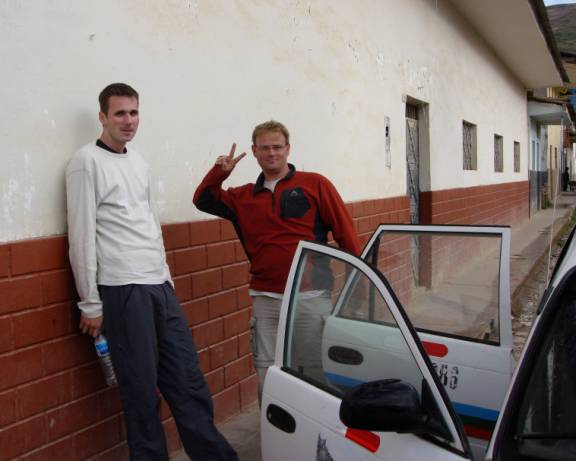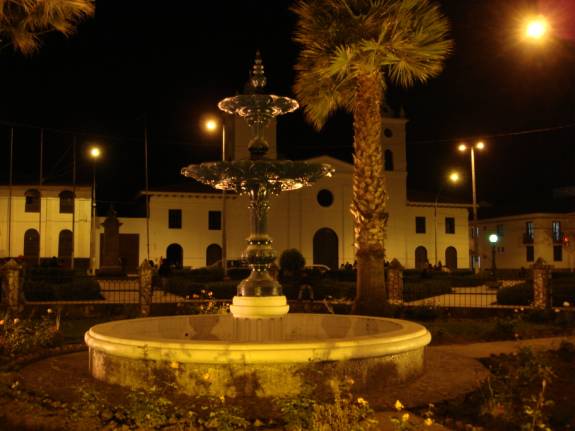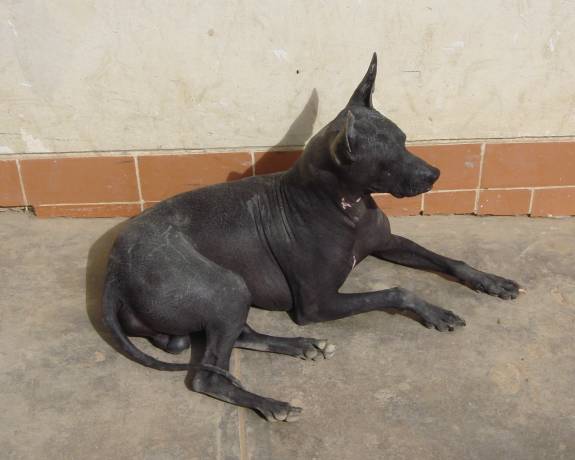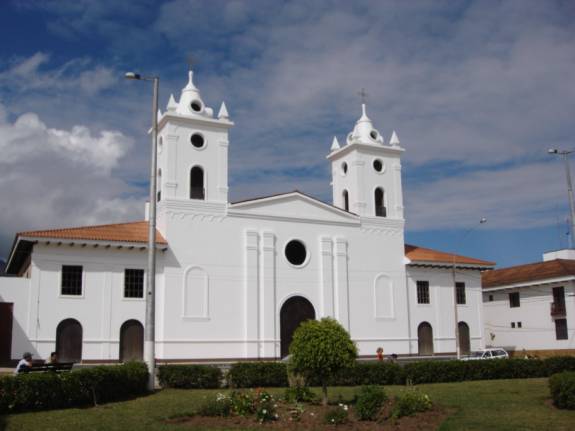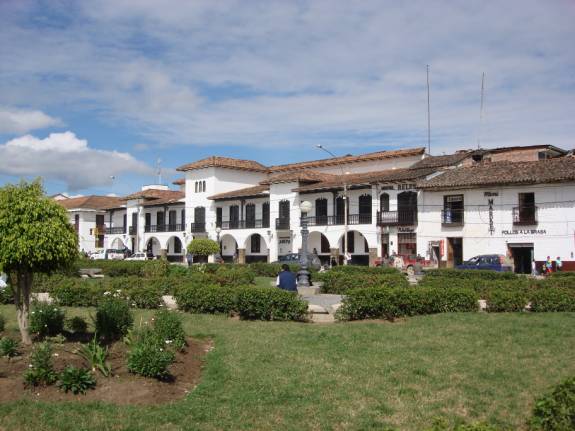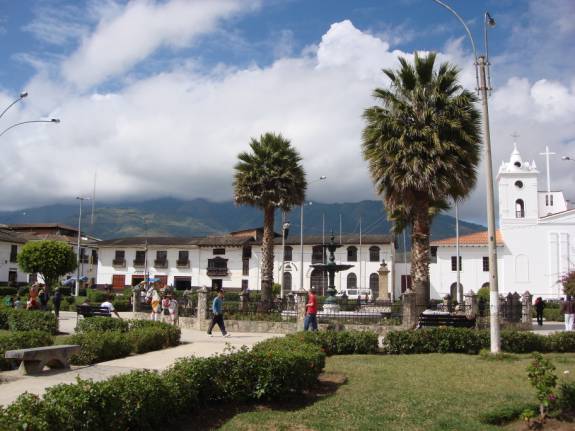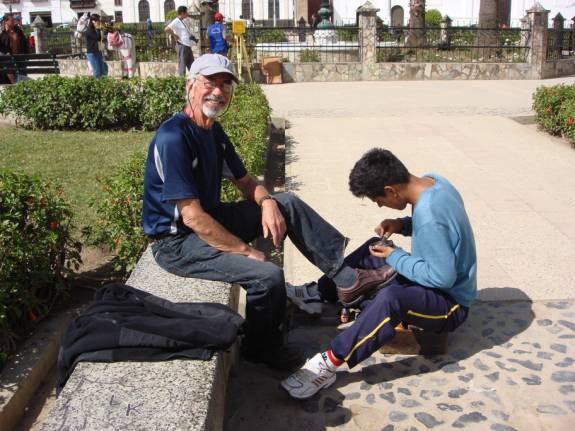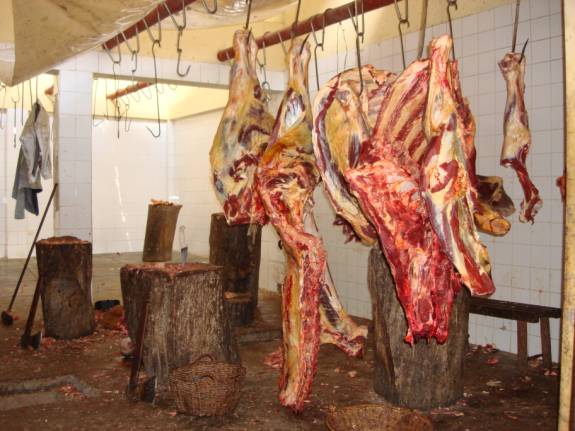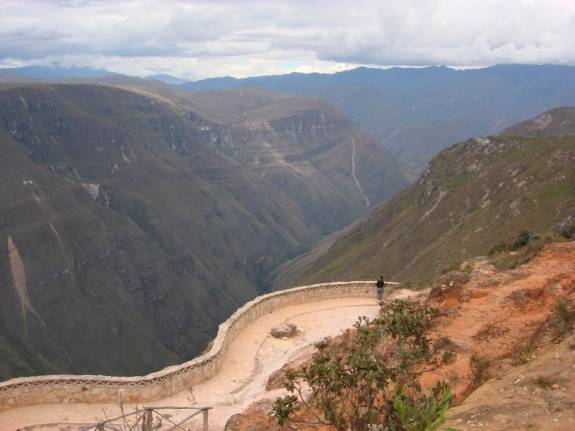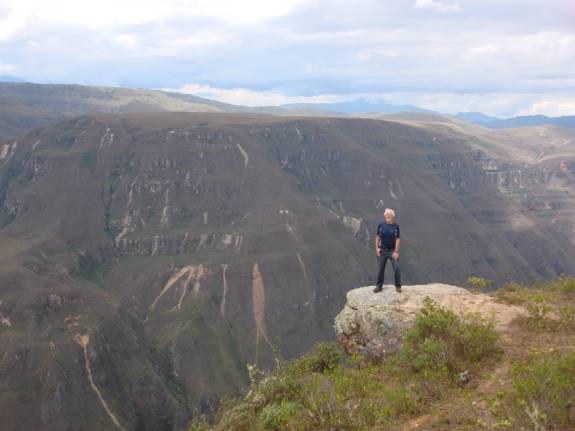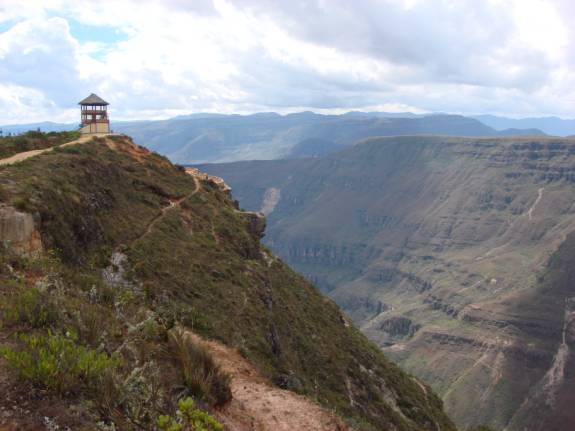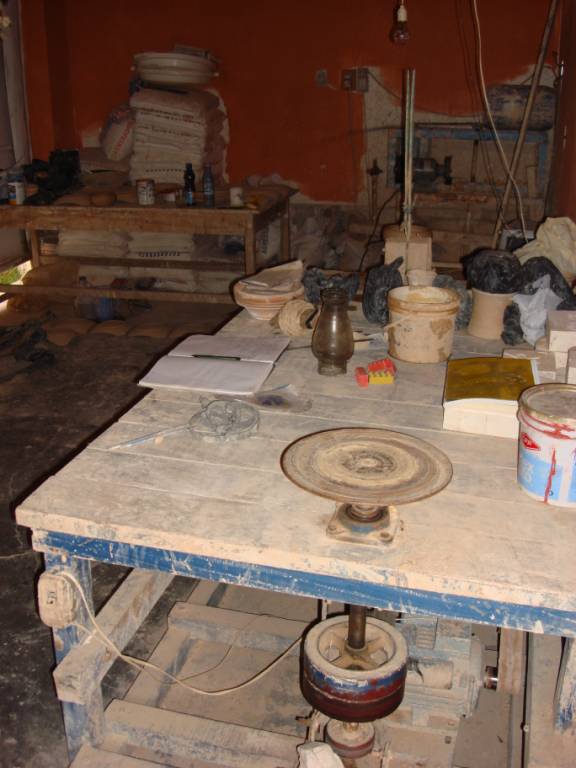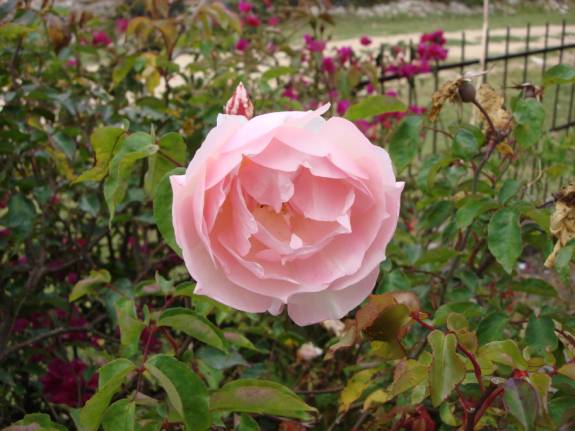|
|
|
|
Site Index:
|
UPDATE#24 07/20 thru 07/22
Howdy
Everybody, The adventures
of 2006, 2007, 2008, and 2009 through 07/19/09 have been published on the
website. We continue with the
latest edition and 5th in the series on Peru and Ecuador. UPDATE
2009 #24 07/20/09 thru 07/22/09 At last update,
we were in Leimebamba
enjoying our adventure trip in the north central highlands of Peru. 07/20/09
MONDAY LEIMEBAMBA, PERU
Comfortable in our room at the Hostal Los Condores, the alarm was
sounding at 7am to remind us that breakfast at Cely’s was in our plan for 7:30
to 8:15am. Our hotel owner, Senor
Julio, arranged for a pair of his best horses and an “arriero”
to take Judy and I through the rural areas and mountains to an ancient
Chachapoyas Culture ruins site.
Because of its relative smallness, some people might be tempted to call
this a, “one horse town”. From
firsthand experience, we would call it a “lots of horses” town.
I think “caballos”
might even outnumber motor vehicles around here.
Once again, we were the only customers at Cely’s Restaurant.
She does a great job but there just aren’t many people around.
In the back room, Cely was getting ready to prepare some upcoming meals.
With her cooking talent, this large animal leg should provide some
excellent results.
At 8:30am, we mounted our trusty steeds for a rugged trip to La
Congona.
The town streets soon gave way to the mountainside trail.
This was definitely not a gentle, equestrian trail ride.
The pathway was rough and untamed…
Guess who’s having a great time?
While we rode, our “arriero” trod on foot to attend to the horses and
our needs. Judy needed a slight
adjustment to her stirrups. In
South America, the “arriero” is a person that leads or urges the animals to
walk. Traditionally, it refers to
those men that work with pack mules and horses along the trails.
Partway, we stopped to water and rest the horses.
We were pleased that these were well cared for horses and, although they
are called upon to do rough duty, they receive considerate and humane treatment.
The weather was nearly perfect. We
had thought it would be chilly so we wore our jackets.
To our surprise, the unexpected warmth soon had us stowing our heavy
outerwear. With each rise in
elevation, the awesome scenic views multiplied exponentially.
To protect and contain the livestock, fencing and wooden gates guarded
the path. At times, the arriero
would guide Judy’s horse up the path.
After a couple of hours of riding on the steep, rutted pathway, we
arrived in the area of La Congona. Believed
to have served as a military-type outpost, the site has a commanding view of the
entire region. Although unrestored,
the remnants make for an interesting visit.
Our arriero pointed out the way and offered some limited explanations in
only Spanish. He spoke zero
English.
Built from stones, the blocks were fashioned into symmetrical shapes and
secureded in position with mud mortar. The La Congona stuctures date from
1100AD to 1350AD. The complex features prominent rhomboidal decorative
stonework, and examples of quadrangular internal cornices.
Exploration of the grounds required a bit of hiking through dense
vegetation and finding a suitable path was a challenge.
I surmised that the slotted holes in the wall were probably used to
support floor beams in this multi-level structure.
Notice the rhomboidal frieze adorning this circular structure…
The important site is said to contain three of the Chachapoyas frieze
designs, including Rhomboidal, Zigzag, and Stepped features.
Notice the zigzag patterning on this frieze design.
Stepped, rock outages can be seen above the inlays.
A bit of rock climbing provided better and closer examination of the
buildings and area.
The site contains the ruins of some 30 structures, including a
watchtower. Some are multi-level
circular buildings with as many as 3 stories.
Notice the combined use of typically Chachapoyas designs on this
building.
Numerous natural plants like these were beautifully growing from the tree
limbs.
The interesting step design was applied here…
Typical rhomboidal pattern found in Chachapoyas architecture…
Following our enjoyable exploration, it was time to mount up.
“Head ‘em Up, Move ‘em Out, Rawhide…”
Sections of the
very narrow trail hugged the steep edges of the mountainous cliffs…
The deeply rutted trail was a challenge for horse and rider…
At least we were in the saddle for the route.
I’m glad that the arriero was the one doing the walking.
Age does have some advantages…
Generally speaking, horses are often more reluctant and hesitant on the
downhill portions of a ride. Our
horses seemed to be well trained and were quite reliable and surefooted.
Judy could be the centerfold girl for “Horse and Rider” Magazine…
After nearly two hours of the descending ride, the town of Leimebamba was
in view…
Riding into town…
With our legs sore and our butts fatigued, we turned the rest of the work
and horse care over to our
arriero, Lázaro.
He will stow the tack, then feed, wash, clean, and brush the horses.
Lázaro told
us that the horses like to chew on sugar cane stalks.
Although he spoke no English, he did a great job for us and we
appreciated it…
By the time we returned from the ride, we were exhausted and felt
justified in just relaxing around the town plaza. We had a chance to visit with
Andrea. He is a young Italian
traveling alone. He had ventured up
to La Congona on foot. We readily
admitted that, at this age in life, we could not have been able to do it.
Our dining experience, of course, was at Cely’s.
She’s the best. For
dinner, Judy chose a roasted pork entrée served with white carrot puree.
I had a delicious soup appetizer followed by specialty of local “Trucha”
(trout fish).
Showering in the nice hot water, then stretching out in the comfortable
bed, made us happy that we had chosen the Hostal Los
Cóndores.
07/21/09
TUESDAY LEIMEBAMBA to
CHACHAPOYAS
It seemed like too short a night when the alarm blasted at 4am.
With an easy walk in the dark to the central Plaza, we found the bus of
Transportes Karlita waiting. I
helped heave our bags up on the roof and we were soon on our way to department
capitol city of Chachapoyas.
A little more than an hour out, the bus experienced a flat tire.
It was still dark and I think I was helpful providing some light from my
pocket flashlight. I wanted to take
a picture but was concerned that I might unnecessarily startle the tire changers
with the bright flash.
Once again, the daybreak revealed more beautiful scenic views.
In the traditional sense of the word, this “arriero”
urged his burdened burro along with gentle prodding.
It was still early when we arrived in Chachapoyas.
We took a look at the Hotel
Revash but found it to be more expensive than expected or warranted.
We decided to check out another place recommended by the Italian traveler
that we had met yesterday. The Hostal Rumi Huasi was the perfect choice for our needs
and the price, after a bit of bargaining, was consistent with our interests.
We hustled back to the Hotel Revash and arranged group transportation,
with Andes Tours, to visit some of the famous sights of the area.
The 8:30am group consisted of just 4 people; Judy, Fred, a Swiss guy, and
a guy from the Belgian Congo. Over
a rough road, the agency driver maneuvered the car and we traveled for about an
hour to the town of Luya.
We paid our entrance tariff and, as required by the local ordinance, we
picked up a local native guide. A
small museum in the town introduced us to some of the strange findings from the
Chachapoyas Culture’s burial sites.
With the local guide stuffed in the rear of the Toyota wagon, we
continued on to the town of
Lamud and the site of “Pueblo de los
Muertos” or “village of the dead”.
A steep trail led down into the beautiful canyon.
The weather was warm and clear.
The principal point of interest is this grouping of funerary statues
situated in the cavernous side of the cliff.
Even
under the limestone overhang, the sarcophagi, called “purunmachus” by the
locals, have suffered significant damages from erosion and the “huaqueros”
(grave robbers). Not all the burial statues are original, some are replicas.
These “chullpas” (mausoleum tombs), have
also been heavily plundered. Having
lost their roofs long ago, the adobe walls continue to collapse at the effects
of the elements. Some researchers claim that examples of
the niche designs closely resemble Egyptian hieroglyphics. Archaeologist
have no definative explanation of any direct association.
It has been determined that these funerary monuments were constructed by
the Chachapoya Culture between 1100 AD and 1350 AD.
Our local guide never spoke even one word in either Spanish or English.
His only function was to show the way and unlock the security gates.
The crumbling walls of the mausoleums are precipitously perched at the
edge of the cliff. Just one careless step would be disastrous.
Human bone fragments can be seen along the sides of some walls.
Was this grinding rock for pulverizing grains, or could it have been used
to grind preservative substances for the dead?
With leg muscles still aching from yesterday’s horseback riding, the
hour-long, steep climb back to the top was quite demanding and very strenuous.
Judy is justifiably proud of the successful physical challenge.
After dropping off the local guide and a lunch break in the town of
Luya, our car continued to the site at
Karajia.
Another challenging path tortured our already stressed physical
endurance.
The main point of interest is tucked in the limestone cliffs.
A group of “purunmachus”
stands on the ledge. Constructed of
stone, wooden staves, and clay, the burial structures honored the noble and
royalty class of rulers. Each
sarcophagus was topped with a human skull.
Another niche in the cliff houses additional monuments.
I continued further along the pathway to get a different view of the
site.
Wisely, we had arranged for a couple of horses to be delivered to the
base of the footpath.
Both of us were well pleased with our decision to ride up and out.
The two horses, and the young girls to lead us out, only cost about $7.
The reduction of stress on our already overly tortured feet and leg
muscles was priceless. Although the
two other young travelers opted to hike out, they regrettably admitted the error
of their personal choice.
In this remote region, the
indígena way of life is a fascinating comparison to more western ways. Long-standing cultural traditions guide and direct most
phases of their lives.
Our youthful fellow travelers; a Swiss and a Belgian from the Congo…
Light rain was falling as we passed back through the town of Luya again.
From Karajia, it had been a two-hour car trip back to Chachapoyas.
It was a quiet evening by the central Plaza de Armas.
Tired, exhausted, and achy, we moved slowly about looking for a good
place to eat while trying to reduce any cramping tendencies in our leg muscles.
Our choice was a chicken grill. Although
cram packed full of people, the chicken was not nearly tender enough for our
liking.
A hot shower and a welcoming bed awaited us at the Hostal Rumi Huasi.
Even though there was a lot of street noise and a loud dog yapping, we
were so tired that we went off to sleep anyway.
07/22/09
WEDNESDAY CHACHAPOYAS
Last night, we made the conscious decision to have a more relaxing
day today. Although we had the
alarm set for 8am, we were awake early with the loud street noises.
A small “Panadería”
(bakery) and cafe provided a good, light breakfast. We searched all over for a “lavandería”
(laundry) to have some clothes washed. I
asked lots of people but got many unproductive answers.
We finally found one at
Avenida Amazonas, 813.
This Peruvian Hairless dog seemed to be enjoying sunning himself in the
morning rays. I am continually
amazed by their strange appearance.
The main church adjacent to the Plaza de Armas…
Wonderful colonial architecture graces the perimeter of the plaza…
In keeping with my relaxation mode, I sat for a shoeshine…
Practices for the handling and butchering of meat products are in sharp
contrast to what we’re used to in the USA.
Axes and tree stumps appear to be the main tools of the trade.
This meaty critter was probably grazing peacefully earlier this morning.
At the recommendation of the
iPeru information office, we took a collective taxi to the town of
Huancas. It wasn’t too far
a walk from there to the
Canon del Sonche.
From the observation tower and a “Mirador”
(viewing balcony), the views of the canyon are spectacular.
On the opposite side, there is a large waterfall tumbling into the river
below.
Judy thought she might get a much more interesting snapshot if I would
only just take one more step backwards. What
do you think?
The tiny village of Huancas has a nice plaza, however, we didn’t see
anybody around to enjoy it.
Strolling around the back streets, we followed a sign to an “artisan”
factory. The small shop creates
pottery items unique to this town.
None of the products displayed in their little gallery interested us
enough to buy…
To our eyes, this rose was the most beautiful creation on the
premises.
When the collective taxi passed through, we joined others for the ride
back to Chachapoyas. The drivers wait until they have a full carload before they
commence their return trip. We
rounded out the load factor and headed back.
We went to Chachas Restaurant near the center for lunch.
We have learned that you have to ask for the daily special, or “menu
del dia”, for the
economical option. Often times,
they just hand you the Ala Carte menu card that lists only their expensive
items. The real deal is seldom listed anywhere so it requires asking
to obtain the value choices.
While out walking later, it started to rain, quickly turning to a heavy,
pelting downpour. We scurried to the good bakery/café. It didn’t take long for the streets to turn to rivers of
muddy water racing toward the central plaza.
As the torrential rains raged, we enjoyed sipping coffee and indulging in
sweets.
When the rains had subsided sufficiently, we started our search for tour
offices providing transportation to the Ruins of
Kuelap.
After numerous inquiries, we chose Chachas Tours located upstairs near
the plaza. Fortunately, I found a
place to download my camera chips to my flash drive.
For dinner, we decided on Chinese food at Chifa Chuy
Xien. Continuing our relaxation
mode at the bakery/café once again, we sat and talked about our future trip
plans while enjoying coconut macaroons and coffee.
We had a nice chat with a French guy.
Changing to a much quieter room #107, we rested
much more peacefully tonight. Tomorrow
will be another challenging day of sightseeing. CONTINUING
UPDATES ARE IN PROGRESS… WATCH FOR THEM, COMING SOON… POST SCRIPT:
We sincerely hope that you will review the previous years of compilations
to give context to the current editions. Please
let us know if you have any special suggestions and thoughts.
REMEMBER: The website
is now fully active and you can visit it at any time.
You can also review any of the previous logs from the years 2006, 2007,
or 2008 and learn more about the crew and their many adventures.
Enjoy. ATTENTION:
SPECIAL NOTE:
You may contact us via email anytime. Thanks
for allowing us to share our life and adventures with you. Lotsa
Luv, Fred
Reed and Judy Law AMARSE MT40 "AMARSE"
is pronounced "AM-ARE-SAY".
Our website is: www.amarse.net .
|
|
Fred H. Reed |
www.amarse.net © 2006 2007 2008 2009 2010 2011 |

